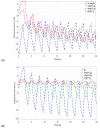Design of Laboratory Stand for Displacement Measurement of IPMC Actuators
- PMID: 36772310
- PMCID: PMC9919193
- DOI: 10.3390/s23031271
Design of Laboratory Stand for Displacement Measurement of IPMC Actuators
Abstract
The polymer technology based on Electroactive polymers and metal composite ionic polymer has great potential and advantages in many engineering fields. In this paper, a laboratory stand for testing Ionic polymer-metal composites (IPMC) is presented. The laboratory station includes a power supply system and a measuring system for the displacement of IPMC composites. Tests and measurements are carried out using a laser transducer and a camera equipped with image analysis software to determine the IPMC strips displacement. The experimental investigation of IPMCs under different voltage supplies and waveforms, environmental working humidity conditions, temperature, and loading conditions has proved the significant influence of geometric dimension and the effect of increased stress on the displacement value. For materials powered by a higher voltage value, an increased deflection value was noted. In case of displacement, longer is the sample, higher is the displacement value. The length of the sample under load, affects adversely its performance, resulting in an increase in the load on the sample. For samples of a thick size, a more stable movement with and without load can be noticed.
Keywords: displacement measurement; electrical characterization; ionic electroactive polymers; thermal camera.
Conflict of interest statement
The authors declare no conflict of interest.
Figures








References
-
- Neuhaus R., Zahiri N., Petrs J., Tahouni Y., Siegert J., Kolaric I., Dahy H., Bauernhansl T. Integrating ionic electroactive polymer actuators and sensors into adaptive building skins–potentials and limitations. Front. Built Environ. 2020;6:95. doi: 10.3389/fbuil.2020.00095. - DOI
-
- Mierzwa-Hersztek M., Gondek K., Kopeć M. Degradation of polyethylene and biocomponent-derived polymer materials: An overview. J. Polym. Environ. 2019;27:600–611. doi: 10.1007/s10924-019-01368-4. - DOI
-
- Tabata Y., Ikada Y. New Polymer Materials. Springer; Berlin/Heidelberg, Germany: 1990. Phagocytosis of polymer microspheres by macrophages; pp. 107–141. (Advances in Polymer Science" book series). Conference paper, part of the “Advances in Polymer Science” book series (POLYMER, volume 94)
-
- Tian X., Liu Y., Wang K., Wang J. Response Mechanism of Soil Carbon and Nitrogen Transformation to Polymer Materials Under Drip Irrigation. J. Soil Sci. Plant Nutr. 2022;22:1351–1361. doi: 10.1007/s42729-021-00737-0. - DOI
LinkOut - more resources
Full Text Sources

